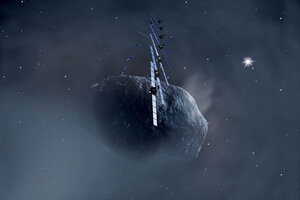Astronomical mystery solved: no caverns in comet
Scientists had long wondered if the low density of comets was a result of a cavernous inside.

The Rosetta orbiter orbiting around the comet 67P/Churyumov-Gerasimenko. Source: ESA
European Space Agency
A new study has answered one of comets' most enduring mysteries.
For the first time, scientists have been able to provide precise measurements and analysis of a comet. Of the 5,507 comets streaming through space, only eight have been visited by human technology. As a result, scientists' understanding of comets, while growing, has lacked answers to many basic questions, according to an European Space Agency press release.
Comets’ densities are low, according to most measurements. The low density has indicated the objects are highly porous, but left questions over whether that was the result of cavernous interiors or just a low-density composition.
A study published in the journal Science proves the inside of a comet consists of “mostly dust and water ice … homogeneous and constant in density on a global scale without large voids.”
A team of scientists with the Rheinische Institut für Umweltforschung an der Universität zu Köln, Germany, came to this conclusion through an experiment measuring the gravitational pull of Comet 67P/Churyumov-Gerasimenko on The European Space Agency's Rosetta orbiter, by analyzing changes in the orbiter’s frequency. As a result of the Doppler effect, the radio frequency the orbiter was beaming to Earth would change when it was pulled by the gravity of the comet, allowing scientists to create a map of the gravitational field around the comet.
“Newton’s law of gravity tells us that the Rosetta spacecraft is basically pulled by everything,” principial investigator Martin Pätzold said in the release.
“… This means that we had to remove the influence of the Sun, all the planets – from giant Jupiter to the dwarf planets – as well as large asteroids in the inner asteroid belt, on Rosetta’s motion, to leave just the influence of the comet. Thankfully, these effects are well understood and this is a standard procedure nowadays for spacecraft operations.”
The analysis also required a touch of cosmic luck. Comet 67P/Churyumov-Gerasimenko has a double-lobe structure, which has allowed the team to gather much more accurate and precise measurements of the gravitational field, according to the release.
“The high porosity seems to be an inherent property of the nucleus material,” the study concluded.
The Rosetta orbiter launched in March 2004 and embarked on a 10-year flight to deep space, where it rendezvoused with Comet 67P/Churyumov-Gerasimenko in 2014.
The Rosetta orbiter was accompanied on its trip by the Philae lander, which landed on the surface of the comet and collected information. The information was sent to Rosetta and the orbiter sent it to Earth. The European Space Agency lost contact with Philae in July. Attempts to reconnect with the lander have been unsuccessful.
Without any chance to reconnect with Philae, Rosetta’s mission will end in September 2016. The press release reports that the Rosetta orbiter will be “guided to a controlled impact on the surface of the comet.”

